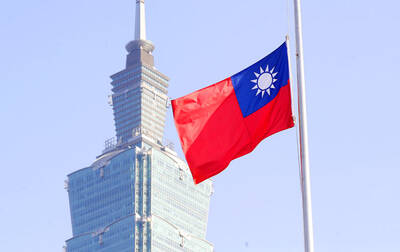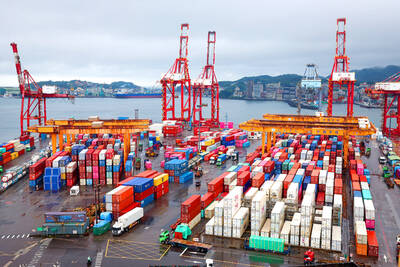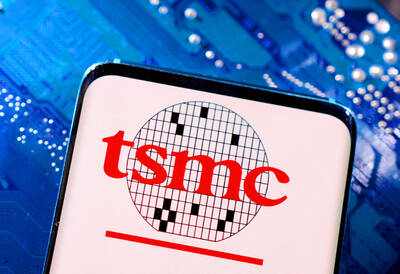Less than a month and a half ago, local semiconductor companies had forecast revenues would decline faster this quarter, with demand during the gift shopping season falling short of expectations.
Now, with a sluggish economy aggravating weak demand, firms desperate to cut costs are forcing employees to take unpaid leave. And, analysts fear, if economies such as the US take long to recover, it could be just the start of more drastic measures.
Local chip companies, including the major competitors, have been opting to cut back workers’ hours in response to shrinking demand. That will remain a key cost-saving measure for companies struggling through a downturn with no recovery in sight.
“For companies that need a lot of capital spending, employee payrolls should not be the key component to their costs and expenses. But small savings can still have a life-saving impact,” said Kenneth Lee (李克揚), a semiconductor analyst with Taipei-based Primasia Securities Co (犇亞證券).
At a computer memory chipmaker, for example, staff salaries generally account for just 5 percent of the cost of its products. Cutting the payroll by 20 percent will only reduce production costs by 1 percent, Lee said.
“The No. 1 goal is to save cash,” Lee said.
Cash-strapped computer memory chipmakers began reducing employees’ working hours last month after cutting output by 15 percent last quarter. A bigger output cut is planned for this quarter to ease oversupply and alleviate huge losses.
Compared with computer memory chipmakers, companies making chips for handsets and consumer electronics are under less stress, but some are on the verge of losing money as demand weakens and could turn to cost-saving measures.
Fitch Ratings has a negative rating on the semiconductor industry as the weaker macroeconomic environment may result in lower revenues for all semiconductor markets. PCs and mobile phones, which represent nearly 60 percent of global semiconductor consumption, could be especially hurt, Fitch Ratings said.
The global semiconductor industry’s revenues may fall by a rate in the high single digits next year from this year, Fitch projected, without providing detailed figures.
The nation’s biggest handset chipmaker, MediaTek Inc (聯發科), was the latest to switch to a more conservative outlook, following the world’s top contract chipmaker, Taiwan Semiconductor Manufacturing Co (TSMC, 台積電), and the world’s two-largest chip packagers, Advanced Semiconductor Engineering Inc (日月光半導體) and Siliconware Precision Industries Co (矽品).
“The global financial storm has started to impact on demand in the emerging markets. End demand for all products is lower than expected,” MediaTek said on Thursday.
Revenue may plunge by more than 30 percent this quarter from NT$28.05 billion in the third quarter, rather than a decrease of between 9 percent and 16 percent estimated in October, the Hsinchu-based chipmaker said.
Last week, TSMC said it had asked its employees in manufacturing departments to take five unpaid days of leave a month beginning this month. In October it said spending on new equipment could drop 20 percent next year.
“The company must do its utmost to lower costs. At the same time, we will also do all we can to protect employees’ jobs,” TSMC chief executive Rick Tsai (蔡力行) said in a video address to employees broadcast online.
“It looks as if this period of economic weakness will last for a fairly long time, and business will become more difficult,” Tsai said.
The day before, TSMC slashed its fourth-quarter revenues and margin forecast by more than 8 percent, bringing the decline to more than 30 percent rather than 26 percent as forecast in October.
MediaTek may not be the last company to lower its forecast for this quarter. United Microelectronics Corp (UMC, 聯電), the world’s second-largest contract chipmaker, could follow suit by revising its forecast, scheduled for release tomorrow, along with the release of its sales figures for last month.
UMC joined its peers in cutting employees’ working hours this month.
The first quarter is usually slacker than the fourth quarter, Lee said, adding that more “extreme measures can be taken to gain more cash if things get worse.”
Those measures include selling old equipment and reducing inventory, which can increase a company’s cash position, and calling cash back from investment subsidiaries, Lee said.
But “any action is possible and every action is difficult,” Lee said.
Amid the slump, investors were trying to identify safer sector leaders with strong net cash positions and small losses or expected to be profitable by next quarter, Citigroup Inc analyst Andrew Lu (陸行之) said in a report.
It seems Taiwan’s TSMC, Siliconware, MediaTek and South Korean Samsung Electronics Co fit this theme, Lu said.

ELECTRONICS BOOST: A predicted surge in exports would likely be driven by ICT products, exports of which have soared 84.7 percent from a year earlier, DBS said DBS Bank Ltd (星展銀行) yesterday raised its GDP growth forecast for Taiwan this year to 4 percent from 3 percent, citing robust demand for artificial intelligence (AI)-related exports and accelerated shipment activity, which are expected to offset potential headwinds from US tariffs. “Our GDP growth forecast for 2025 is revised up to 4 percent from 3 percent to reflect front-loaded exports and strong AI demand,” Singapore-based DBS senior economist Ma Tieying (馬鐵英) said in an online briefing. Taiwan’s second-quarter performance beat expectations, with GDP growth likely surpassing 5 percent, driven by a 34.1 percent year-on-year increase in exports, Ma said, citing government

‘REMARKABLE SHOWING’: The economy likely grew 5 percent in the first half of the year, although it would likely taper off significantly, TIER economist Gordon Sun said The Taiwan Institute of Economic Research (TIER) yesterday raised Taiwan’s GDP growth forecast for this year to 3.02 percent, citing robust export-driven expansion in the first half that is likely to give way to a notable slowdown later in the year as the front-loading of global shipments fades. The revised projection marks an upward adjustment of 0.11 percentage points from April’s estimate, driven by a surge in exports and corporate inventory buildup ahead of possible US tariff hikes, TIER economist Gordon Sun (孫明德) told a news conference in Taipei. Taiwan’s economy likely grew more than 5 percent in the first six months

SMART MANUFACTURING: The company aims to have its production close to the market end, but attracting investment is still a challenge, the firm’s president said Delta Electronics Inc (台達電) yesterday said its long-term global production plan would stay unchanged amid geopolitical and tariff policy uncertainties, citing its diversified global deployment. With operations in Taiwan, Thailand, China, India, Europe and the US, Delta follows a “produce at the market end” strategy and bases its production on customer demand, with major site plans unchanged, Delta president Simon Chang (張訓海) said on the sidelines of a company event yesterday. Thailand would remain Delta’s second headquarters, as stated in its first-quarter earnings conference, with its plant there adopting a full smart manufacturing system, Chang said. Thailand is the firm’s second-largest overseas

Taiwan Semiconductor Manufacturing Co’s (TSMC, 台積電) market value closed above US$1 trillion for the first time in Taipei last week, with a raised sales forecast driven by robust artificial intelligence (AI) demand. TSMC saw its Taiwanese shares climb to a record high on Friday, a near 50 percent rise from an April low. That has made it the first Asian stock worth more than US$1 trillion, since PetroChina Co (中國石油天然氣) briefly reached the milestone in 2007. As investors turned calm after their aggressive buying on Friday, amid optimism over the chipmaker’s business outlook, TSMC lost 0.43 percent to close at NT$1,150